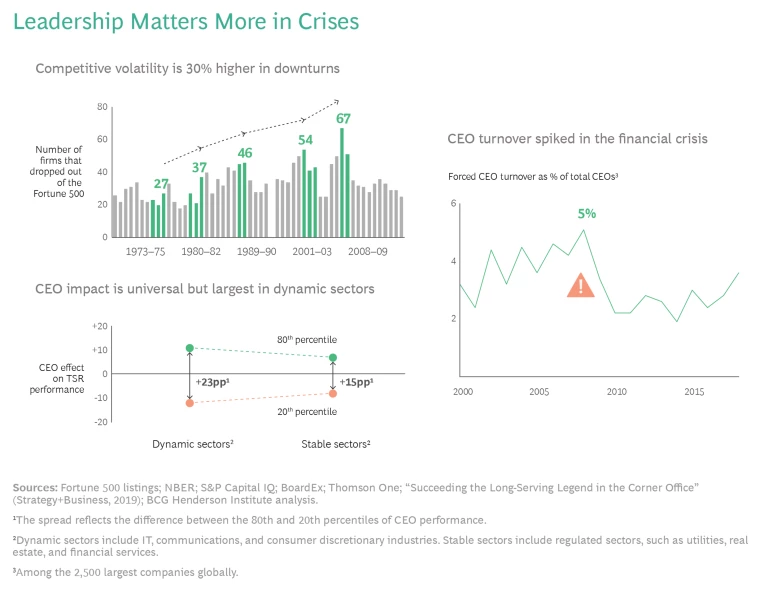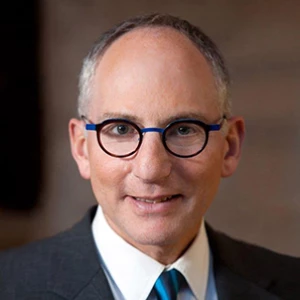History is filled with stories of leaders who rise to the challenge of a crisis and those who crumble under its weight. How are leaders handling today’s crisis, and what can we learn from what they have said and done?
We recently analyzed leadership performance and found that companies run by strong CEOs generate shareholder returns more than 20 points higher than those run by weak CEOs. They overperform by leading differently along many dimensions. (See “What Successful CEOs Do Differently.”)
What Successful CEOs Do Differently
- Winning leaders take a long-term, outward-focused approach to purpose and strategy. They focus on the future, not just the present. They engage in “biological thinking,” a measure of adaptability and flexibility well-suited for understanding complex systems, especially in times of crisis. Their approach to strategy extends beyond financial performance and matches a firm’s capabilities and aspirations with societal needs.
- Winning leaders emphasize nonfinancial and financial performance alike. They increase their companies’ environmental, societal, and governance scores at twice the rate of underperforming CEOs. The best-performing CEOs did especially well on governance.
- Winning leaders act early. The total shareholder return of companies whose CEOs undertook transformation in their first year is higher than the TSR of companies whose CEOs waited. This finding suggests that acting early and decisively during the crisis is the right approach.
The coronavirus crisis has stretched and put those dimensions to the test. Leaders have had to protect the health of their people, maintain morale and business momentum, navigate demand shocks, and adjust strategy. And they have had to do it all remotely—knowing too that industry volatility and CEO turnover are highest in crises. (See the exhibit.)
In our conversations with more than 100 CEOs about leading through the crisis, they emphasized six themes that are consistent with what we found in our long-term study on CEO performance. We heard many stories emphasizing the importance of purpose as a guide to action, a long-term approach to strategy, and the tracking of high-frequency signals. Since the crisis began, most CEOs have spent even more energy taking care of their people, communicating authentically, and honing their own leadership abilities.
Purpose Guides Action
Purpose anchors an organization’s day-to-day activities to a higher goal. It is a company’s reason for being that underlies what it does, makes, or sells. CEOs have drawn from the well of purpose to handle the crisis. “By reminding teams of our purpose and why we are working hard, we can do more to handle the crisis, strengthen our reason for existing, and help a greater number of people,” one CEO said. Another told us, “My people are asking how we are going to help, both in communities and globally. As CEOs, we need to think about how we can help societies and how giving our people a sense of power to create some good links to our value proposition.”
One CEO talked about how purpose enabled her to help “people move beyond grief to action” while another emphasized that “by reminding teams of our purpose and why we are working hard, we can do more to handle the crisis and strengthen our reason for existing.”
One company that didn’t have a purpose before the pandemic is now developing one. “It isn’t just useful now, it will also be hugely useful for the future, especially if the crisis lasts another year or two,” the CEO explained. “Purpose motivates a lot of people, especially when you can articulate that what you are doing is more than just making money.”
Purpose motivates a lot of people, especially when you can articulate that what you are doing is more than just making money.
The Future Is Now
Many CEOs have said that they are working simultaneously on today’s issues and on setting up their respective companies for success in the new reality. As economic activity returns, these CEOs are increasingly thinking through moves for a postvirus world. One CEO shared that his leadership team is now spending one-fifth of its time focused on the longer term, a larger share than normal. “You can’t just put out fires. The crisis brings opportunities. It unleashes a springboard for accepting changes,” suggested another CEO. “We’re looking to adapt how we work, making supply chains local instead of global. We are also changing how we get products to customers and how customers can interact with our products safely.”
One CEO’s springboard is another’s platform. “For the first two months, we left strategy behind. But then we split our work in two. What do we do during the recovery, which could last two years? What do we do in the long term? We found that the crisis is a great platform to extend strategic initiatives, such as digital transformation, beyond the core business.” And even amid uncertainty, companies can set their sights on fixed targets. “We chose to narrow our focus to what you can control, such as digital penetration and other strategic priorities that will not be affected by the state of the economy,” one CEO said. “We then aligned with the board on our plan to have shorter, surer, and simpler goals.”
The Signals That Matter Most
CEOs have been forced to find new signals to understand the business, markets, and overall economy during the pandemic. With quarterly metrics all but meaningless in the chaotic early days, CEOs have looked to high-frequency data for signs of employee health, business activity, and future trends. “We’re seeing five years of change in five weeks, and that velocity is going to continue,” explained one CEO. “We don’t currently have forecasting capabilities for projecting demand in six to nine months or the ability to predict consumer changes across geographies, so we’ve moved to shorter-term targets,” added another.
CEOs have been forced to find new signals to understand the business, markets, and overall economy during the pandemic.
One CEO said his company was trying to predict future demand by looking more closely at customer segments and described the “need to understand the demand environment because it will be a long time before we return to normal.” Careful tracking of high-frequency consumer data “tells us what the curves will probably look like to help us manage expenses and change,” as one CEO put it.
CEOs with large operations in the US and in many emerging markets outside of Asia also need to be especially attuned to national, state, and local regulations as the virus threatens business activity. “One of the most difficult risks to manage is that varying regulations drive responses to the lockdown in the US,” observed one CEO.
People First
CEOs have recently had to address employee safety, anxiety, uncertainty, job security, performance expectations, and burnout—sometimes in the same conversation. It’s a tall task that demands clear action and communication. “We need an intentional plan to communicate with employees, customers, communities, and vendors on how to get through this together,” one CEO said. Another told us, “We gave an advanced bonus to our employees and a special award to thank people working in our stores; essential workers are our most important asset and we have to take care of them.”
Executives have also had to contend with the rise of remote work. According to one CEO, “Working from home is good for some and not so good for others. It is challenging to keep a sense of unity and purpose now that the crisis is no longer in the early phases and there are deep psychological impacts to consider.”
The crisis has helped us uncover talent.
New leaders have emerged during the crisis. One CEO has begun to empower and recognize leaders who excelled in the past few months by having them present their work to the board. “The recognition mattered more than a bonus. They know that they’re valued,” he explained. “One of the things that has been really powerful for me,” another mentioned, “is how much the crisis has helped us uncover talent deep in the organization that had been suppressed or overlooked in better times.” This emergence of a new generation of leaders is a silver lining of the crisis. One CEO remarked, “We now have a clear view of our star leaders, as well as those who have not been able to rise to the challenge. It’s a great opportunity to find out who can make a difference to the business.”
Communication Demands Authenticity
The coronavirus upended whatever communications and employee feedback programs companies had in place, leaving the CEO as the communicator in chief and, in the words of one CEO, the “storyteller in chief.” CEOs have had to tell stories about safety, job security, demand shocks, and strategy. These are big roles to fill in the age of Zoom. One lamented, “I will forever be the ‘virtual CEO.’”
Without the familiar forum of face-to-face meetings, CEOs have tried to connect through remote channels. “I aspire to build a personal connection so my employees will know me on a personal level,” one CEO said. “A health crisis deserves a human response. People are looking for a vulnerable, calm, and clear-thinking leader.”
Leaders are also finding ways to generate feedback and a feel for employee sentiment. As one CEO said, “It’s very hard to know what’s going on behind the scenes. It’s important to find ways to check in informally and read between the lines, even online. I try to have a conversation with my people every week in different mediums to create clarity.” One CEO sets unstructured time during meetings for allowing employees to “heal and nurture” and “to chat and get to know each other as we go through this together.”
This is not a time for corporate speak, as comfortable as its ambiguities can be. One CEO suggested the following test to determine if a CEO is getting through: “If you asked an employee at any level ‘What would the CEO want me to do?’ would they have an answer?” Many leaders have had to grapple with tough questions about layoffs and other sensitive topics. One CEO recounted that following a lot of debate in a meeting, he explicitly stated that he does “not anticipate staff reductions but can't guarantee that for the future.” His rationale? “Authenticity and honesty pay off every time.”
Leading Through the Crisis
Most CEOs recognize that they are facing what will likely be the largest test of their tenures. Every word and action can inspire or be misunderstood. “This is an opportunity to train empathy, self-awareness, and breakout thinking,” one CEO said. “You need breakout thinking to see the future, and you need self-awareness and empathy to connect and understand your own purpose, the purpose of the company, and to know how to shape your company’s future.”
Most CEOs recognize that they are facing what will likely be the largest test of their tenures.
A new CEO said that the pandemic has been his baptism by fire. “Without this crisis,” he explained, “I might have been more tentative to act. It has accelerated my ability to engage.” For others, it’s all about moving forward. “Our challenge is to maintain realism and optimism and prepare for a wider range of scenarios,” one CEO said. “We need to use COVID-19 as an opportunity to be stronger and as a benchmark for the art of the possible.”
In our work with CEOs, we collaborate frequently with Frank Blake, an outstanding leader with extensive board experience, who became CEO of Home Depot shortly before the Great Recession. Blake offered the following advice based upon his role in the last major global business crisis and his deep involvement in this one: “In five years, you’ll be rolling up your sleeves and showing scars and telling others, ‘You wish you would have been there.’ This is a great time to lead. Today’s scars are tomorrow’s stripes.”
Leaders who embrace this challenge will be better prepared to create new, powerful opportunities to replace those robbed by the coronavirus.













